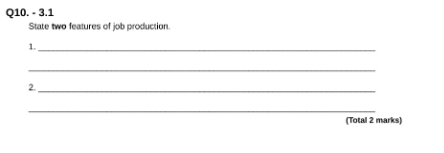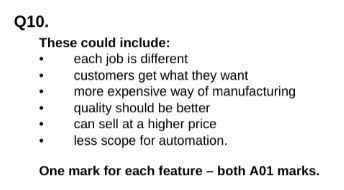3.1 - Production Processes
1/37
There's no tags or description
Looks like no tags are added yet.
Name | Mastery | Learn | Test | Matching | Spaced |
|---|
No study sessions yet.
38 Terms
What is production?
A transformation process that changes resources into goods and services
What is the input stage of production?
This includes resources, such as natural resources and raw materials
What is the process stage of production?
When the input is transformed into finished products
What is the output stage of production?
The output is the finished product or service
What is labour intensive production?
What are the advantages of labour intensive production?
What are the disadvantages of labour intensive production?
What is capital intensive production?
Capital intensive is when products are mainly produced by machines and robots, meaning the initial investment and maintenance will be very high.
What are the advantages of capital intensive production?
What are the disadvantages of capital intensive production?
What is job production of products?
Each time a new product is made, changes may need to be made to the production process. It is highly specialised and very labour intensive.
What is an example of job production?
Some examples of job production may include made-to-measure clothes, handmade crafts and bridges.
What are the advantages of job production?
What are the disadvantages of job production?
What is flow production?
Flow production occurs when a business makes large numbers of identical products on a continuous production line.
Give some examples of flow production products
Some of examples of flow production include chocolate bars, televisions and bottled drinks.
What are the advantages of flow production?
What are the disadvantages of flow production?
What is lean production?
Lean manufacturing is based on minimising costs and maximising efficiency by cutting down on waste and the amount of materials and energy used in production.
What are the seven wastes?
What is overproduction?
Producing goods before customers demand them - high storage costs and possible damage to goods waiting to be sold
What is waiting?
Whenever goods are not moving on to the next stage of production
What is transporting?
Too much handling can cause damage
What is unnecessary inventory?
Having too much stock takes up space and gets in the way of productive activity
What is motion?
What is over processing?
Using complex equipment to carry out tasks can be wasteful
What is defects?
Products that are poorly made have to be rejected, and time is wasted inspecting for faults
What is Just In Time production?
When a business holds no stock and instead relies upon deliveries of raw materials and components to arrive exactly when they are needed (when a customer places an order)
What are the advantages of JIT production?
What are the disadvantages of JIT production?
What is efficiency in business?
What is Kaizen?
The process of introducing constant small improvements to a business' processes. Employees are encouraged to suggest improvements, as they deal with these processes on a daily basis
How can efficiency in business be measured?
How does Kaizen benefit employees?
How does Kaizen benefit the business?
What are the negatives of Kaizen?
What is production management?
An area of management concerned with designing and controlling the process of production

